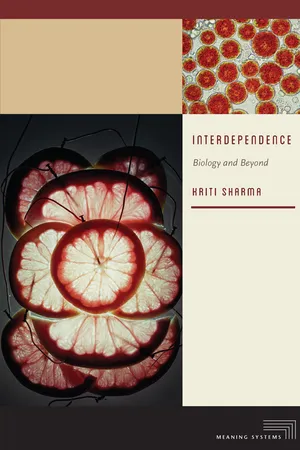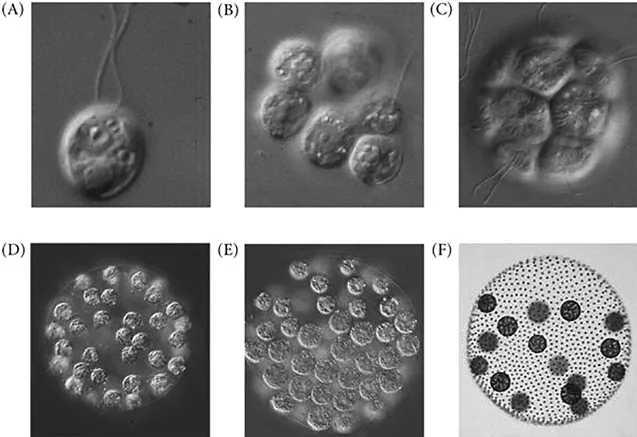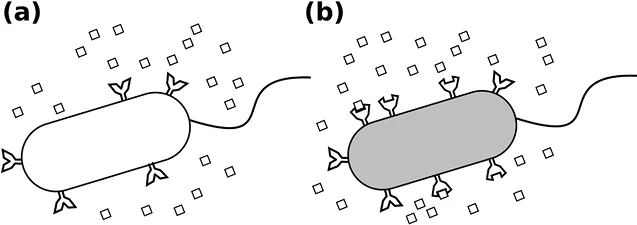![]()
1
It Depends
Contingent Existence
Small Worlds
Not existence, not reality, but algae: That is what I had entered graduate school in biology to study. I had wanted to research how cells organize themselves into multicellular collectives and what was necessary for the transition from solitary to multicellular life. I was enamored of a creature called Gonium dispersum, a (barely) multicellular alga. The evolutionary ancestors of this genus are free-living single cells, and its evolutionary descendants are multicellular (Figure 1.1). Gonium dispersum lives on the cusp of solitary and multicellular life. Most of the time, the alga exists as an eight-celled aggregate. However, sometimes, the cells separate from each other and go their separate ways—hence, dispersum. “So much like us,” I thought. “The cells are one kind of living being on their own, and a whole new kind when they’re all together.”
Figure 1.1. Algae of the family Volvoaceae, the genera of which are characterized by their number of cells, arrangement of cells, and differentiation of cells. The genus Gonium is characterized by four- to sixteen-cell aggregates, undifferentiated and arranged on a flat plane. (a) unicellular Chlamydomonas reinhardtii; (b) eight-celled Gonium pectorale, whose undifferentiated cells are arranged on a flat plane; (c) sixteen-celled Pandorina morum, whose undifferentiated cells are held together at the base and form a sphere; (d) thirty-two-celled Eudorina elegans, also undifferentiated and arranged as a sphere; (e) sixty-four-celled Pleodorina californica, whose cells are originally similar but differentiate and dedifferentiate over time as reproductive and nonreproductive types; (f) Volvox carteri, whose cells are fully differentiated early in development into reproductive and nonreproductive types. Courtesy of David Kirk.
These more or less multicellular organisms abound in the world. A sea sponge passed through a fine sieve will disaggregate into individual cells that will eventually find each other again and reform a whole, functioning sea sponge. The soil amoebae of the species Dictyostelium discoideum normally live as free-living single cells, but when they start to starve, they go multicellular. The cells signal to each other, aggregate, form a multicellular slug made up of hundreds of individual amoebae, and collectively migrate to a new location, forming a mushroom-like body, and then dispersing again as single cells (Figure 1.2).
Figure 1.2. Development of the soil amoeba Dictyostelium discoideum. Under stressful conditions, the single cells aggregate and form complex multicellular bodies. Counterclockwise from bottom right: flat loose aggregate; domed tight aggregate; tipped aggregate; finger shape; hat shape; early culminant; later culminant (mushroom-shaped); fruiting body; fully differentiated spore body, with basal disk, stalk, and spores. The motile slug-shaped aggregate is shown on the bottom left. The aggregate will sometimes migrate to a new location in this slug-shaped form. Courtesy of M. J. Grimson and R. L. Blanton, Biological Sciences Electron Microscopy Laboratory, Texas Tech University.
These transitions from solitary to multicellular life (and sometimes back again) made me wonder how single cells even recognize each other. How do Dictyostelium cells find each other to form an aggregate? How do they sense each other? For that matter, how do they sense anything at all? Do they differentiate between a fellow Dictyostelium amoeba and a sand particle, or bacterial prey? Are social organisms more responsive to members of their own species (called conspecifics) than solitary organisms? Do they have more faculties to perceive their conspecifics? For example, lions as social cats may be highly sensitive and responsive to the presence and behaviors of other lions, whereas tigers as solitary cats may be comparatively impoverished in terms of what they sense of other tigers. Similarly, cells that live in “societies” might have more “senses” (that is, more signal-response systems) attuned to cues from other cells (Figure 1.3, a and b), whereas free-living single cells might have relatively few means to sense and respond to other cells (c and d).
Figure 1.3. Cells and their “social senses.” Cells secrete molecules into their environments (represented by stars) and have molecules upon their surfaces (represented by black rectangles). These molecules may be sensed by other cells, or conspecifics, as depicted in (a) and (b). Signal-response systems can bind the secreted molecules (as in (a)) or the cell-surface molecules (as in (b)) and produce a response in the cell (illustrated by the cell turning a darker color). “Naïve” cells that have no such signal-response systems, as depicted in (c) and (d), would be unresponsive to these molecules, and thus would be less capable (or perhaps incapable) of sensing the presence of conspecifics.
I thought about “naïve” solitary cells, cells that have no means of perceiving their fellows. A conspecific could be brushing right up against their boundaries (d), and they would not be able to distinguish that from a ripple in the water. This is the same situation as if a cell were non-responsive to anything else in its environment. The cell could be totally surrounded by a certain sugar, but with no means of interacting with that sugar in any specific way (Figure 1.4a). The sugar is there to a human observer, but to the cell, it’s not there. The cell does not sense it at all. If the cell lineage evolved proteins that bound the sugar, and this binding created some kind of response, then we could say that the cells became able to sense the sugar (Figure 1.4b). Now we might say that the sugar is there, not just to the human observer, but also to the cell. The cell, of course, does not call what is there “sugar.” However, I thought, “There is some thing in the medium, English-speaking humans call that thing ‘sugar,’ and the cell senses and responds to that same thing in some way.”
Figure 1.4. Evolving novel signal-response systems. (a) A cell surrounded by sugar (white squares) is not necessarily responsive to the sugar in the absence of signal-response systems capable of binding the sugar. (b) Over evolutionary time, a descendant may arise with proteins that bind the sugar (transporters, signal transduction proteins, or other types).
I had started off asking, “Why do some kinds of cells respond to the presence of their fellows and others do not?” Then I asked the broader question, “How do cells evolve the ability to sense all kinds of things that their ancestors could not?” or in other words, “How do new senses evolve?” However, all of these questions seem to assume that things are already out there, and if organisms evolve the appropriate senses, organisms can start perceiving the things. Red objects have really been out there in the world for billions of years, and primates became capable of seeing that redness when they evolved eye proteins that are sensitive to red light. Ultraviolet light was out there, and was perceived by bees and later detected by human ultraviolet-detecting technologies. Similarly, sugar was out there and at some point in time began to be sensed by cells.
However, it is as reasonable to ask, “How do new things come into being for organisms?” as it is to ask, “How did new senses evolve?” In other words, when cells begin to sense sugars, a new “thing” comes into being for the cells. In a specific and important sense, the sugar did not exist as a thing before cells started to interact with it. Thus, organisms could be seen as “thing makers” in a world that is not necessarily full of things prior to the thing-making activities of organisms. I unpack the idea of a “thingless world” at length in Chapter 2 on objects and the external world, the idea of “thing-making activities” in Chapter 3 on signal transduction and sensing, and the idea of organisms as thing makers who make even themselves into things in the Chapter 4 on subjects and organismal selfhood.
The question “How do organisms sense the world?” is often read as, “How do organisms, with various degrees of completeness and accuracy, sense the one real world that exists independently of all of their perceptions?” Indeed, this was exactly how I read it when beginning to research cells and their senses. However, like many before me, I saw the problem in this formulation: There is no peeking at the world independent of perceptions. All we get as organisms ourselves are perceptions and conceptions. And so, at this point in the inquiry, I began searching for and contemplating ways to think about the real world that do not assume its existence independent of perceptions. That’s when things started to get really interesting.
Introducing Key Concepts: Reality, Existence, and Contingency
First, we might ask, what would it even mean for the real world to exist independent of perceptions? To do this, we can begin by unpacking the term “existence.” Philosopher Jay Garfield does this nicely:
When we ask of a phenomenon, Does it exist?, we must always pay careful attention to the sense of the word “exist” that is at work. We might mean exist inherently, that is, in virtue of being a substance independent of its attributes, in virtue of having an essence, and so forth, or we might mean exist conventionally, that is to exist dependently, to be the conventional referent of a term, but not to have any independent existence.
Throughout this book, I use the words “existence” and “reality” carefully, as Garfield suggests. I use the term “inherent existence” interchangeably with “intrinsic existence,” “intrinsic reality,” and “substantiality.” I use “contingent existence” instead of Garfield’s “conventional existen...




